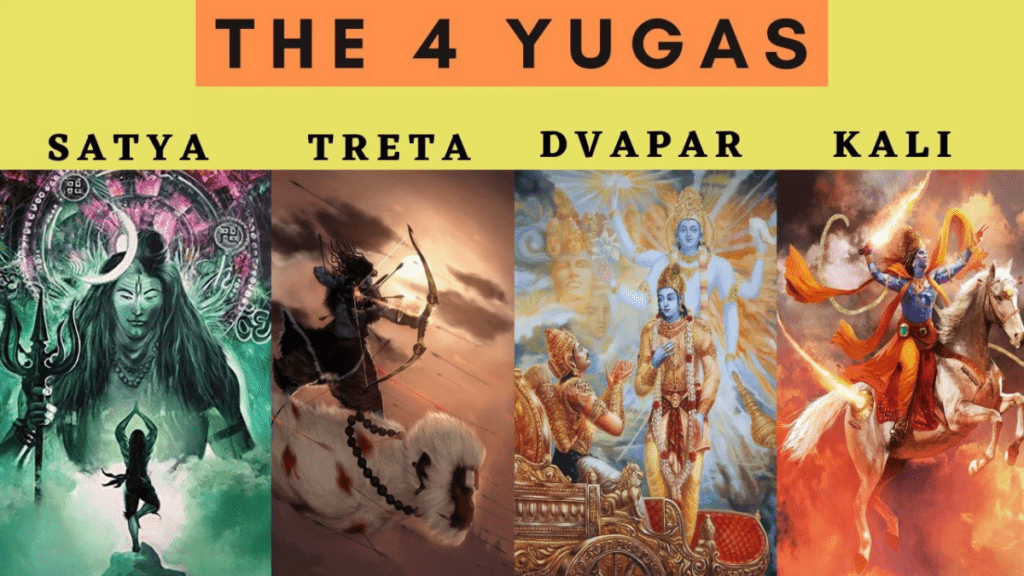In Hinduism, when we describe the love and bond of two brothers, we refer to them as Ram and Lakshman. Ramayana taught us about the sacred relation of brothers and showed how modern relations should be.
However, both Ram and Lakshman were Vishnu avatars who appear to restore dharma whenever evil rises and threatens virtue. As per records and mythological saying, they both appeared for the first time in Treta yuga, then again reincarnated in Dwapara yuga. There is a reason and an interesting story behind it, but first, let’s explore how yugas work for a clear understanding.
What are Yugas?

A yuga cycle is a cyclic age in Hindu cosmology. There are four yugas, and as the process progresses, the lengths, humanity, morality, and physicality decrease by one-fourth.
1. Satya Yuga
It was said to be the sacred age where everything was pure, everyone spoke the truth and lived with peace and harmony. There are no records of Adharma or demons in Satyuga; many believe that Gods used to live on earth during Satyuga. It was the golden age!
Of course, it’s over, but the yuga lasted for 17,28,000 years. It was started in 3,891,102 BCE.
2. Treta Yuga
It arrived after Satyuga, where God left the Earth for heaven, and some mightier demons successfully established their empire to promote dharma. It was still not that bad compared to other yugas that were about to come. In this Yuga, people still believed in the power of good and mostly lived in harmony.
Treta yuga was started in 21,63,102 BCE and it lasted for 12,96,000 years.
3. Dwapara Yuga
Things got worse in Dwapara yuga; despite killing Ravana and founding dharma in Treta yuga, the evil established their rule in Dwapara yuga. People have lost their respect for females as the “Chir Haran” and battle of Mahabharat were fought in Dwapara Yuga. Still, Lord assassinated all evils to establish dharma.
Dwapara Yuga started in 8,67,102 BCE and lasted for 8,64,000 years.
4. Kali Yuga
It is said to be the worst yuga where people find peace in the problems of others. It’s believed that things will get worse as yuga progresses; humans will become very small, worse than animals, with no respect and safety for women and things that you couldn’t imagine will happen in future. We currently live in Kali Yuga, and it’s just started.
Similar to other Yugas, it’s already predicted that whenever evil overpowers, the lord will appear to establish Dharma. Kali Yuga started between 3102 BCE – 428,899 CE and will last until humanity collapses for about 4,32,000 years.
Story of Ram and Lakshman in Treta Yuga

Ram is the incarnation of Lord Vishnu, whereas Lakshman is the manifestation of Sheshnag (an enormous serpent full of anger, loyal to Lord Vishnu, and always living beside him). Whenever the lord appears on Earth to establish Dharma, he always brings Sheshnag with him in human form.
The Sheshnag always appears to have a strong relationship with the lord, like Ram and Lakshman, the brothers. Despite being half-brothers, they are like one soul in two bodies.
Ram’s mother is Kaushalya; she was King Dashrath’s first Queen, while Lakshman’s mother was Sumitra, the King’s third wife.
Both have multiple stories together that teach a lot about how our relations should be.
1. During Ram’s vanvas, Lakshman voluntarily appeared (leaving the kingdom) to serve his brother and his wife, Mata Sita. They don’t face any difficulties during exile to ensure their safety and look.
2. Lakshman never looked at Mata Sita with ill intentions. Some stories say that he even never looked at her face. He was so deeply attached to his brother that he never did anything without his consent.
3. Not once but twice, he risked his life for Ram. Always ensured that his brother was safe and whole-heartedly served him on the battlefield.
4. He left his newly wedded bride Urmila in Ayodhya to serve his brother.
It’s impossible to find such devotion in current society, but we can at least apply one teaching of the Lord in our lives.
However, this is the story of Ramayana in Treta Yuga that everyone knows about. Even the next incarnation is pretty popular.
Story of Krishna and Balram in Dwapara yuga

Lord Vishnu, who appeared as Ram in Treta Yuga now incarnated as Krishna, whereas Sheshnag, who appeared as Lakshman in Treta Yuga, is not incarnated as Balram. Sheshnag requested lord Vishnu to allow him to guide him this time, which is why he incarnated as his elder brother to Krishna.
The story of half-brothers remains the same in Dwapara Yuga as well. Krishna’s mother was Devaki, Vasudeva’s second wife, whereas Balram’s mother was Rohini, Vasudev’s first wife.
Again, in Dwapara yuga, both have interesting stories that teach life lessons. The biggest lesson was that despite Krishna being the superior lord, he easily agreed to appear as a younger brother and always showed compassion and kindness towards his elder brother, Balram.
Krishna addressed Balram as Dau (elder brother) to show gratitude and respect towards him. He never argued; instead, always helped his brother every time. Krishna’s kindness and unconditional love towards his brother teach us huge moral lessons.
Like Lakshman, Balram didn’t find the same role in Dwapara yuga as Krishna was the sole Sarathi of Arjuna in the most discussed battle of Mahabharat. Still, we can find many incidents that show the love and fun of brothers.
Conclusion
Whenever evil overpowers virtue, Lord Vishnu incarnates as a human on Earth to destroy evil and establish dharma. So, what’s worse than Kali Yuga?
It’s already predicted that in Kali Yuga lord will incarnate as Kalki for the tenth and final time. Vaishnava Cosmology explains that he will appear at the end of the Kali Yuga to establish Dharma when evil is at its highest.

